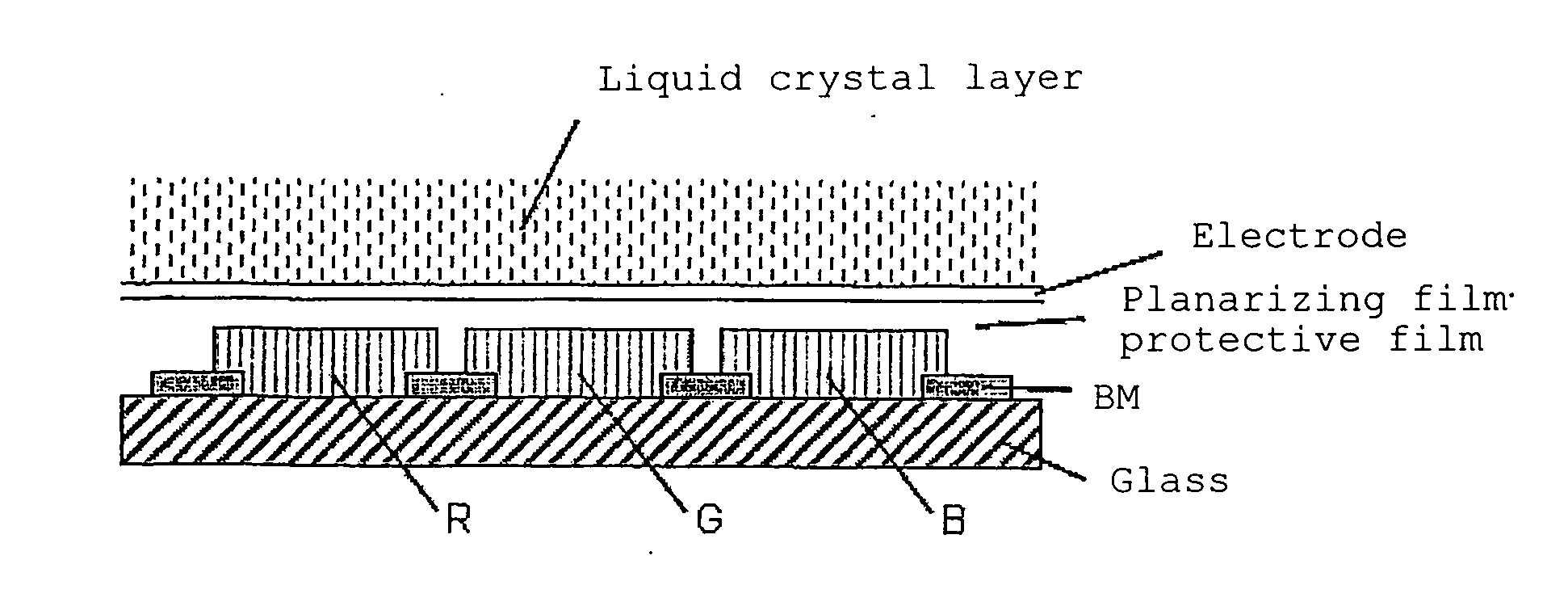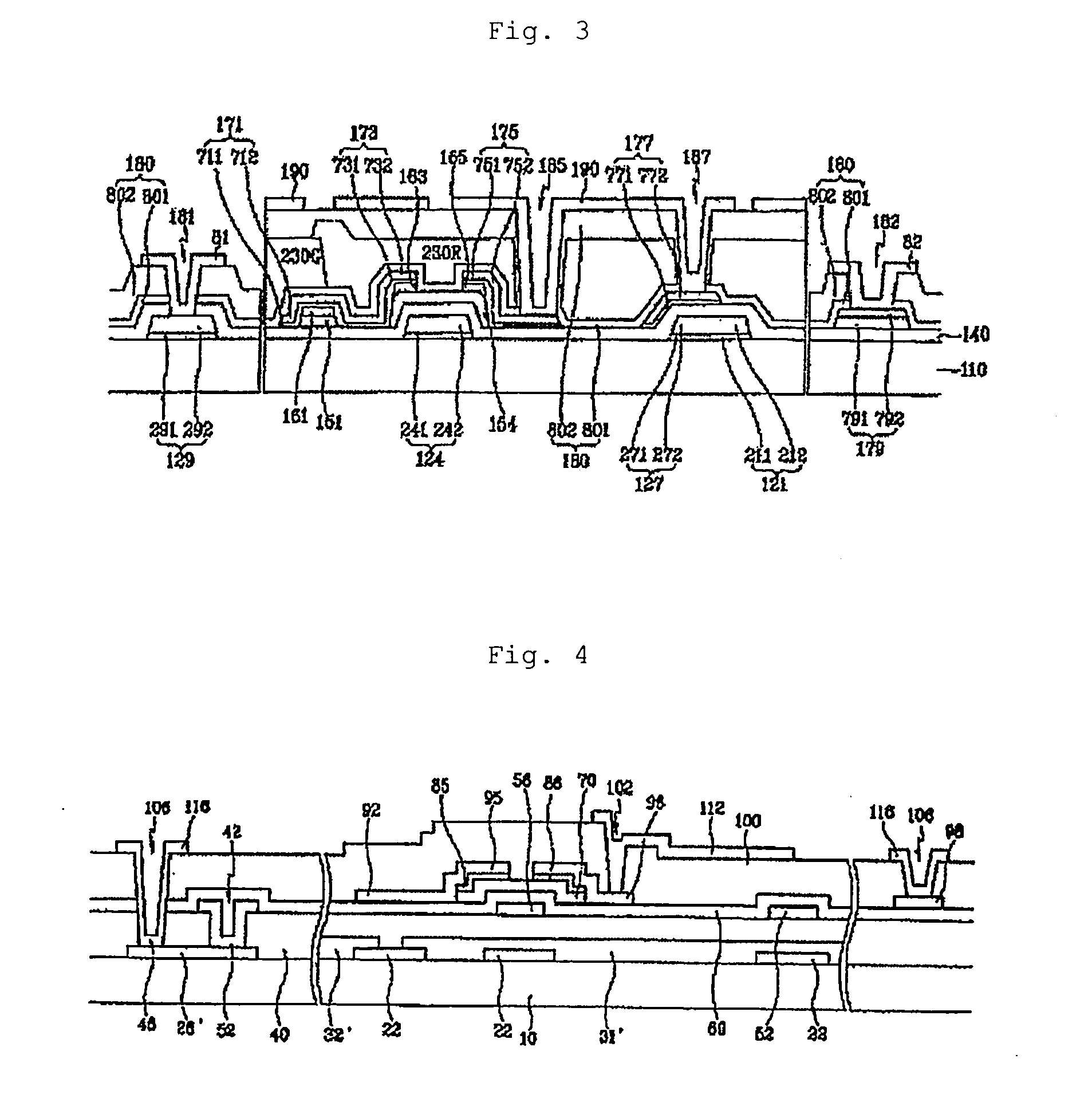Radiation sensitive resin composition and method of forming an interlayer insulating film
a technology of radiation sensitive resin and composition, which is applied in the direction of photosensitive materials, instruments, photomechanical equipment, etc., to achieve the effects of improving process efficiency, high light transmittance, and excellent heat discoloration resistance and adhesion to the substra
- Summary
- Abstract
- Description
- Claims
- Application Information
AI Technical Summary
Benefits of technology
Problems solved by technology
Method used
Image
Examples
synthesis example 1
[0132]7 parts by mass of 2,2′-azobis(2,4-dimethylvaleronitrile) and 220 parts by mass of propylene glycol monomethyl ether acetate were fed to a flask equipped with a condenser tube and a stirrer. Subsequently, 22 parts by mass of methacrylic acid, 23 parts by mass of tricyclo[5.2.1.02,6]decan-8-yl methacrylate, 5 parts by mass of p-methoxystyrene, 50 parts by mass of 3-ethyl-3-methacryloyloxymethyl oxetane and 3 parts by mass of α-methylstyrene dimer were fed to the flask and stirred gently while the inside of the flask was substituted by nitrogen. The solution was heated at 70° C. and kept at this temperature for 4 hours so as to obtain a polymer solution containing a copolymer [A-1].
[0133]The solids content of the obtained polymer solution (the ratio of the polymer mass to the total mass of the polymer solution, the same shall apply hereinafter) was 31.1 mass %, and the polymer had a weight average molecular weight of 17,200 and a molecular weight distribution (weight average mol...
synthesis example 2
[0134]7 parts by mass of 2,2′-azobis(2,4-dimethylvaleronitrile) and 220 parts by mass of diethylene glycol ethyl methyl ether were fed to a flask equipped with a condenser tube and a stirrer. Subsequently, 13 parts by mass of methacrylic acid, 50 parts by mass of glycidyl methacrylate, 10 parts by mass of 3-ethyl-3-methacryloyloxymethyl oxetane, 10 parts by mass of N-cyclohexylmaleimide, 10 parts by mass of N-(3,5-dimethyl-4-hydroxybenzyl)methacrylamide and 7 parts by mass of tetrahydrofurfuryl acrylate were fed to the flask and stirred gently while the inside of the flask was substituted by nitrogen. The solution was heated at 70° C. and kept at this temperature for 4 hours so as to obtain a polymer solution containing a copolymer [A-2].
[0135]The solids content of the obtained polymer solution was 32.1 mass %, and the polymer had a weight average molecular weight of 18,200 and a molecular weight distribution of 1.8.
synthesis example 3
[0136]7 parts by mass of 2,2′-azobis(2,4-dimethylvaleronitrile) and 200 parts by mass of diethylene glycol ethyl methyl ether were fed to a flask equipped with a condenser tube and a stirrer. Subsequently, 11 parts by mass of methacrylic acid, 12 parts by mass of N-phenylmaleimide, 9 parts by mass of p-methoxystyrene, 50 parts by mass of glycidyl methacrylate, 10 parts by mass of 3-ethyl-3-methacryloyloxymethyl oxetane, 5 parts by mass of n-lauryl methacrylate, 3 parts by mass of 1-(tetrahydropyran-2-oxy)-butyl-3-en-2-one and 3 parts by mass of α-methylstyrene dimer were fed to the flask and stirred gently while the inside of the flask was substituted by nitrogen. The solution was heated at 70° C. and kept at this temperature for 5 hours so as to obtain a polymer solution containing a copolymer [A-3].
[0137]The solids content of the obtained polymer solution was 32.4 mass %, and the polymer had a weight average molecular weight of 21,200 and a molecular weight distribution of 2.1.
PUM
 Login to View More
Login to View More Abstract
Description
Claims
Application Information
 Login to View More
Login to View More - R&D
- Intellectual Property
- Life Sciences
- Materials
- Tech Scout
- Unparalleled Data Quality
- Higher Quality Content
- 60% Fewer Hallucinations
Browse by: Latest US Patents, China's latest patents, Technical Efficacy Thesaurus, Application Domain, Technology Topic, Popular Technical Reports.
© 2025 PatSnap. All rights reserved.Legal|Privacy policy|Modern Slavery Act Transparency Statement|Sitemap|About US| Contact US: help@patsnap.com



